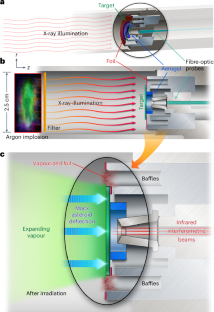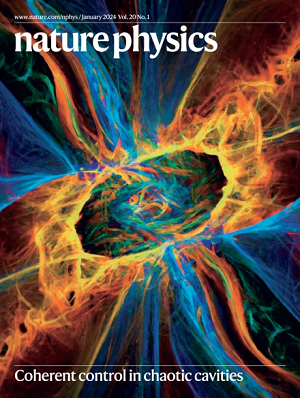用兆焦耳级 X 射线脉冲模拟小行星偏转
IF 17.6
1区 物理与天体物理
Q1 PHYSICS, MULTIDISCIPLINARY
引用次数: 0
摘要
奇克苏鲁伯小行星撞击引发了大灭绝、特大海啸和持续约 10 万年的全球变暖。虽然美国国家航空航天局(NASA)最近的双小行星重定向试验任务表明,可以成功瞄准近地天体,但要偏转最危险的小行星,需要类似核爆炸的能量集聚。然而,适合实践任务的目标却很少。在这里,我们演示了用来自桑迪亚国家实验室脉冲功率装置 Z 机器产生的高密度氩等离子体的 X 射线脉冲模拟小行星偏转。我们使用所谓的 X 射线剪刀将代理小行星材料放入自由空间,同时切断支撑物并使目标表面汽化。随之而来的爆炸加速了按比例小行星拦截任务中的模拟小行星材料。硅质目标的偏转速度约为 70 m s-1,与辐射流体力学模型的预测结果一致。我们将这些结果与拟议的拦截器能量相匹配,并预测直径达 (4 ± 1) 千米的小行星可以通过这种机制发生偏转,这表明为未来的行星防御任务做好准备是一种可行的方法。本文章由计算机程序翻译,如有差异,请以英文原文为准。


Simulation of asteroid deflection with a megajoule-class X-ray pulse
The Chicxulub asteroid impact triggered mass extinction, mega-tsunamis and a spell of global warming that lasted for around 100,000 years. Although the recent Double Asteroid Redirection Test mission by NASA demonstrated that near-Earth objects can be successfully targeted, deflecting the most dangerous asteroids will require energy concentrations akin to nuclear explosions. However, targets suitable for practice missions are scarce. Here we demonstrate the simulation of asteroid deflection with an X-ray pulse from a dense argon plasma generated at the Z machine, a pulsed power device at Sandia National Laboratories. We use so-called X-ray scissors to place surrogate asteroidal material into free space, simultaneously severing supports and vapourizing the target surface. The ensuing explosion accelerates the mock asteroidal material in a scaled asteroid intercept mission. Deflection velocities of around 70 m s–1 for silica targets agree with radiation-hydrodynamic model predictions. We scale these results to proposed interceptor energies and predict that asteroids up to a diameter of (4 ± 1) km can be deflected with this mechanism, showing a viable way to prepare for future planetary defence missions. Deflection is one of the options discussed for preventing catastrophic collisions of asteroids with Earth. Now, a megajoule-class X-ray pulse is used to simulate such scenarios, demonstrating that it is a viable strategy at higher interceptor energies.
求助全文
通过发布文献求助,成功后即可免费获取论文全文。
去求助
来源期刊

Nature Physics
物理-物理:综合
CiteScore
30.40
自引率
2.00%
发文量
349
审稿时长
4-8 weeks
期刊介绍:
Nature Physics is dedicated to publishing top-tier original research in physics with a fair and rigorous review process. It provides high visibility and access to a broad readership, maintaining high standards in copy editing and production, ensuring rapid publication, and maintaining independence from academic societies and other vested interests.
The journal presents two main research paper formats: Letters and Articles. Alongside primary research, Nature Physics serves as a central source for valuable information within the physics community through Review Articles, News & Views, Research Highlights covering crucial developments across the physics literature, Commentaries, Book Reviews, and Correspondence.
 求助内容:
求助内容: 应助结果提醒方式:
应助结果提醒方式:


